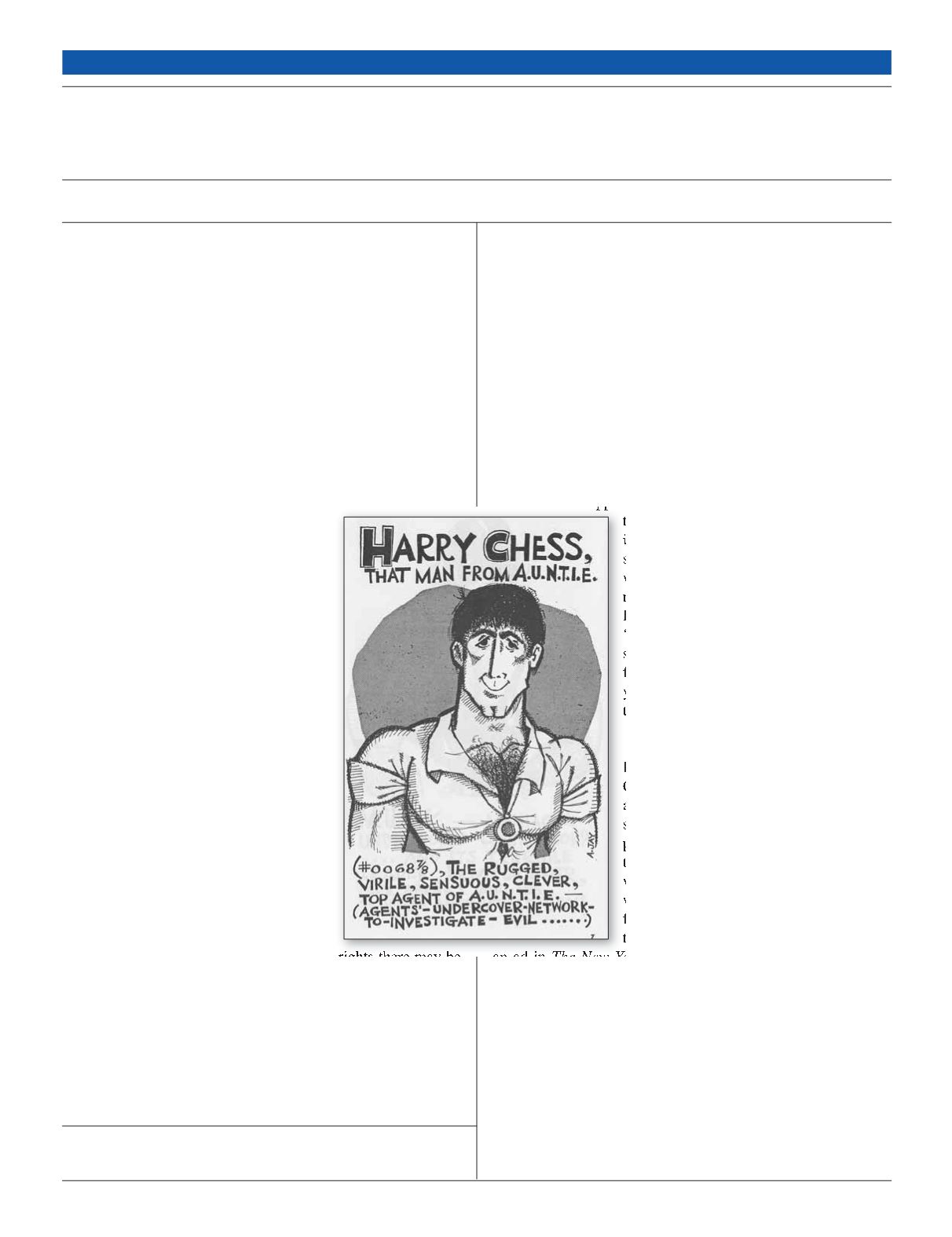
T
HE WORLD’S FIRST gay comic strip was ar-
guably
Harry Chess: That Man from A.U.N.T.I.E.
,
which first appeared in the Philadelphia ho-
mophile publication
Drum
from 1965 to ’66. The
strip pits the hirsute pectorals of protagonist
Harry Chess, secret agent #0068 7/8 of the
Agents’ Undercover Network to Investigate Evil (A.U.N.T.I.E.),
and his muscular but monosyllabic teenage “assistant” Mickey
Muscle, against a series of colorfully evil and sexually naughty
nemeses. Although its title was inspired by the 1964-68 televi-
sion series
The Man from U.N.C.L.E
., the strip was a campy and
(homo)sexually explicit spoof of the larger international espi-
onage genre with its futuristic gadgets, shadowy acronymic or-
ganizations, and morally ambiguous secret agents whose
exploits were regularly punctuated by gratuitous sexual en-
counters. But more than just another ex-
ample of the mock-Bond phenomenon,
Harry Chess
demonstrates the important
role of popular visual culture in the mid-
1960s emergence of a gay liberationist sen-
sibility in the U.S.
Harry Chess
resulted from a funda-
mental shift in priorities and tactics within
the Philadelphia-based Janus Society, one
of a number of homophile organizations on
the Eastern seaboard. In 1963 Janus elected
as its president Clark P. Polak, a candidate
who was openly critical of the organiza-
tion’s past leadership, and promised a more
structured, business-like organization with
a strong community presence. But beyond
organizational reform, Polak rejected the
Janus Society’s strategies, which tended to-
ward accommodation and assimilation, in
favor of a gay-centered and sex-affirmative
politics. In a 1966
Drum
editorial, he de-
scribed earlier homophile activists as “a
group of Aunt Marys who have exchanged
whatever vigorous defense of homosexual rights there may be
for a hyper-conformist we-must-impress-the-straights-that-we-
are-as-butch-as-they-are stance. It is a sell-out.”
Recalling that in mid-century gay slang “auntie” was a pejo-
rative term for an older, effeminate gay man, we can understand
that the virile, handsome, and above all masculine Harry Chess
really was “that man
from
A.U.N.T.I.E.”—a departure from older,
seemingly outmoded modes of gay sensibility. Polak was per-
haps at the more radical edge of a general shift, evident in other
ESSAY
The Lives and Times of Harry Chess
M
ICHAEL
J. M
URPHY
Michael J. Murphy is assistant professor of Women and Gender Stud-
ies at the University of Illinois, Springfield.
mid-1960s homophile organizations, toward a positive revalua-
tion of homosexuality and a rejection of scientific and medical
expertise on “the homosexual” in favor of the personal authority
and everyday experience of actual gays and lesbians.
Key to realizing Polak’s vision was the Janus Society’s
monthly newsletter, which he renamed
Drum: Sex in Perspec-
tive
. Featuring national and international news coverage, editori-
als, cultural reviews, advice columns, parodies, and, of course, a
comic strip,
Drum
was the prototype of later gay lifestyle publi-
cations such as
Genre
and
Out
. With
Drum
, Polak sought “to put
the ‘sex’ back into ‘homosexual,’” a goal reflected in the how-to
column “A Beginner’s Guide to Cruising” and the use of male
physique photography on the cover. An ad in the NewYork Mat-
tachine Society newsletter (November 1964) succinctly charac-
terized
Drum
’s approach: “
Drum
stands for a realistic approach
to sexuality in general and homosexuality
in particular.
Drum
stands for sex in per-
spective, sex with insight and, above all, sex
with a sense of humor.
Drum
represents
news for ‘queers,’ and fiction for ‘perverts.’
Photo essays for ‘fairies,’ and laughs for
‘faggots.’”
Drum
’s combination of news,
sex, and humor proved immensely success-
ful. Circulation topped 10,000 after two
years, with a print run two or three times
that of other homophile publications.
T
HE
B
IRTH OF
H
ARRY
In 1964, Polak placed classified ads in East
Coast newspapers seeking “a cartoonist for
a new gay and sophisticated magazine.” (A
subsequent form letter responding to ap-
plicants suggests that a great many car-
toonists misunderstood Polak’s use of the
word “gay,” a fact that probably explains
why newspapers accepted the ad in the
first place.) Allen J. Shapiro, a Pratt Insti-
tute of Art-trained illustrator, responded to
an ad in
The New York Times
with an 11” x 14” drawing of
Harry Chess wearing bikini underwear, signed with the pen
name “A. Jay.” Polak later remembered thinking: “That was it.”
The Harry Chess character first appeared in
Drum
’s November
1964 issue as a graphic accompaniment to the parody “Franky
Hill: Memoirs of a Boy of Pleasure,” and the stand-alone comic
strip debuted in the April 1965 issue. The strip was a collabo-
rative product, with Shapiro first roughing out the story, then
meeting with Polak to fine-tune the humorous dialogue.
Harry Chess: That Man from A.U.N.T.I.E.
borrowed the
popular Bond film formula, but re-imagined it from a mid-
1960s gay male perspective, for a gay male audience, to affirm
22
The Gay & Lesbian Review
/
WORLDWIDE


